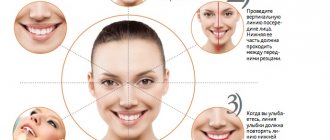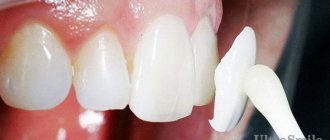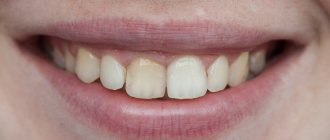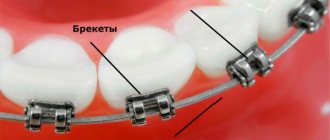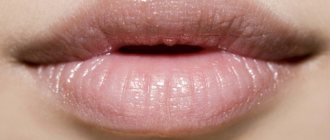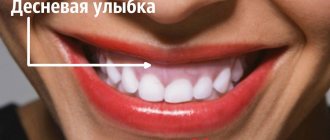If you want to improve the appearance of your smile, if you don’t like something about it, but you cannot accurately and correctly formulate what exactly, if you want to talk with your dentist about the aesthetics of your smile in the same language, then the following note is just right for you.
Nature (or God... depending on your views on life) has made us different. And our originality and uniqueness have its own charm. But what to do when this uniqueness goes too far beyond our ideas of beauty? How to formulate your claims to nature (and perhaps to the previous intervention of dentists)? To assess the aesthetic component of our face, lips, teeth - everything that gives rise to a beautiful, harmonious smile, it turns out that there are many parameters. This is what dentists use (at least should use) when planning changes in your appearance. Since there are very, very many different nuances, and I do not have the task of making each of you an expert in the field of aesthetic dentistry , we will focus on the ten simplest and most important.
Parallelism of horizontal landmarks.
One of the most important signs of a harmonious smile is the parallelism of imaginary lines: the interpupillary line (in the picture there is a blue line connecting the right and left pupil of the eye) and the lip line (in the picture there is a red line drawn between the corners of the mouth).
Both of these lines should also be parallel to the lines connecting the edges of the central incisors (green) and the incisal cusps of the canines (blue)
Gum level.
A smile looks attractive and more aesthetically pleasing , in which the line connecting the necks of the teeth (shown in dotted lines) repeats the line of the upper lip, and the level of gum exposed when smiling is symmetrical on the right and left. At the same time, with a maximally open smile, only the gum “triangles” between the teeth and a small strip of gum above them (no more than 2-3 mm wide) should be noticeable.
Thus, the gums around the upper teeth, upper and lower lips form a kind of frame for your smile. If the “picture” is not visible behind the frame, then such a smile will not look attractive.
Excessive visualization of the gums (the so-called “gummy smile”) is most often eliminated with the help of surgery, orthodontic treatment, as well as cosmetic interventions (for example, Botox injections into the upper lip, upper lip augmentation, etc.).
Rate your appearance
- Use your own reflection in the mirror, smile in your usual way and freeze. Soberly evaluate all the flaws in your appearance.
- Take a closer look at how much you grin and whether your gums are visible. Assess the curvature and condition of the teeth. Don't be shy in your exercises, no one is watching you.
- If visible flaws are identified, try to limit your smile to your lips, without exposing your teeth. If possible, use the services of a dentist.
- First of all, restore all the teeth if they are missing. Then, if necessary, resort to braces. After that, whiten your teeth and learn to smile properly again.
Vertical symmetry and midline.
A line passing through the center of the face should pass exactly between the central incisors of the upper jaw. The discrepancy between these lines causes a feeling of disharmony even with a quick glance at your smile from the outside. In this case, it is not at all necessary that it also passes between the central lower incisors. Firstly, a complete match is rarely found, and secondly, this in no way affects the aesthetic perception of your smile when viewed from the outside.
What to do if your bad mood won't let go
You don’t always have a good mood; how can you keep your face up if you want to cry? Try to have a slight smile on your face, not to glow like a copper teapot, but to “bloom” sweetly and easily.
Even if you are in a bad mood, there is no need to frown; cheerful, friendly facial expressions will act on others like hypnosis.
You will see that people will treat you with care and kindness. And this attitude will make your mood much better.
Try to remember a funny joke or a pleasant event, such as your baby's first steps. A kind smile will involuntarily play on your face.
"Golden proportion".
The principle of the golden proportion in relation to a smile in aesthetic dentistry is that when looking at it from the front strictly in the center, the ratio of the apparent width of the front teeth should be approximately the following - 0.6 (width of the canine): 1 (width of the lateral incisor): 1.6 (width of the central incisor ).
As can be seen in the photo, the width of the visible part of the remaining teeth (4s, 5s) should consistently decrease, creating a sense of perspective.
Practical recommendations
- Practice in front of a mirror, achieving facial symmetry. Smile as much as possible, strengthening your muscles. After some time of intensive manipulation, the face will get used to it. The result will become obvious.
- Always try to show a radiant smile, charming those around you. Do it from the bottom of your heart with glowing eyes. Otherwise, the smile will look unnatural, implying malice.
To achieve a stunning smile, you have to work hard. Systematically perform facial exercises to strengthen your muscles. Identify all deficiencies and contact a dentist. Become a confident person, stop being shy. Having achieved a charming smile, do not stop practicing in front of the mirror, also do all the exercises.
Proportions of the tooth.
The central incisors of the upper jaw always attract special attention, because... best visible when talking and smiling. Therefore, it is very important that their proportions are correct. The most harmonious looking teeth are those with a ratio of tooth width to length of approximately 0.7-0.8: 1
However, at different ages this ratio may change. Due to the physiological wear of teeth in older age, this ratio tends to be 1:1. Therefore, if you want to “rejuvenate” your smile, you usually need to increase the length of the tooth.
Secrets of a charming smile
In addition to exercises, there are other techniques.
- Training in front of a mirror will help consolidate the results, because your face will gradually get used to the new position.
- Once you put on a radiant smile, you will see the friendly attitude of the people around you. You'll love it!
- Stop smoking and drinking coffee often to avoid damaging your teeth.
- Use whitening at least once a month.
- Maintain facial symmetry. You will never be able to smile sweetly if your face is distorted. Achieving symmetry is difficult, but it is necessary. Go to the mirror, smile, maintaining symmetry. Remember this state!
- Approaching the mirror, press the corners of your lips with your fingers and make cute facial expressions. Practice, it will do you good.
- If after several trainings your fingers do not find the edges of your lips, repeat this exercise again until this facial expression begins to work out by itself.
Interincisal angles.
Interincisal angles are the spaces between the cutting edges of the anterior group of teeth.
With the harmonious construction of teeth, these angles should gradually increase from the center to the periphery: from a small closed angle between the central incisors, to a more direct and even open angle between the 2nd and 3rd teeth.
Tooth wear leads to a decrease or complete absence of interincisal angles, which makes the patient look older when he smiles.
At the same time, “female” teeth are characterized by rounded corners of the incisors, while “male” teeth are characterized by straighter ones.
Zenith of the gingival contour.
The zenith of the gum is its most concave part around the neck of the tooth (indicated by dots in the photo).
The level of zeniths near different teeth in the smile zone should be at different levels. For the central incisors and canines - approximately at the same level (or slightly higher for the canines), for the lateral incisors - slightly lower than both (as shown by the lines in the photo). At the same time, it is equally important that the zeniths on symmetrical teeth are at the same level. This is especially important to consider if this area becomes noticeable when smiling. When even with the most open smile the gums are not exposed, then there is no serious need to set the zeniths perfectly symmetrically.
In this case, attention is drawn to the too low zenith level on tooth 12; it is significantly lower than the symmetrical tooth 22. There is also a slight difference in the position of the zeniths on the central incisors (teeth 11 and 21). As a result of treatment, these shortcomings were eliminated, as can be seen in the first photo.
Why do you need to do exercises?
By strengthening your facial muscles, you will be able to freely use your facial expressions and create a sincere smile.
And sincerity can disarm any enemy, improve relations with a strict boss, and quickly conclude a business agreement.
When you feel like crying out of despair, blur out from your heart and you will feel much better. You will soon feel that your sadness is not so terrible, you will want to have fun and laugh. If you made a mistake, a shy smile will help smooth it out. Children use this technique and everything is forgiven for them.
If a person has grief or sadness, try to help him by simply smiling, encouraging, helping with advice.
Position of cutting edges.
The cutting edges of the central group of teeth are also located at different levels. For the central incisors and canines - approximately at the same level, for the lateral incisors - slightly higher (as marked by lines in the photo).
Again, due to the abrasion of teeth with age, the cutting edges of the teeth become at the same level, the line connecting them takes on a straight rather than convex appearance, and sometimes (with increased pathological abrasion) even concave. Therefore, to make a smile more “youthful,” you need to return the relationship of the cutting edges to a harmonious one.
It can also be noted that the dominance of the central incisors over the lateral incisors and canines also gives the smile a more youthful appearance.
The dominance of the canines, their sharp, prominent cutting cusps, make the smile more aggressive. This effect is based on the fact that in nature, long, sharp, well-developed fangs are characteristic of predators, whose entire philosophy of existence is based on aggression towards their prey.
Gymnastics for lips
You may know how to smile correctly, but your muscles just can't create the right smile. Fortunately, they can be trained with simple exercises. All of them need to be done 3-5 times:
- Stick your tongue out as far as possible, hold for 3 seconds and return back;
- Exhale sharply, as if you were blowing out a candle;
- Exhale slowly through pursed lips. After exhaling, relax your facial muscles and smile as wide as possible;
- Open your mouth a little and start chewing, like camels chew. Try to move your cheekbones as far as possible. You can try making a figure eight with your lower jaw;
- Sing the sounds A-I-O-U loudly, one at a time, in one breath. Then inhale again, puff out your cheeks and exhale, creating a slight vibration of your lips;
- Exhale slowly through your pursed lips, as if creating pressure;
- Stretch your lips forward as much as possible, fold them into a tube and open and close them like a fish;
- For three minutes, try to whistle any melody as loudly and clearly as possible.
Interdental gingival papillae.
The gingival papilla is the part of the gum that fills the interdental space (marked with lines in the photo).
The location and appearance of the papillae is determined by the underlying bone, which has exactly the same contour. In the most optimal option, the tops of the gingival papillae are located as in the photo (marked with dots) - between the central incisors the gingival papilla is longest, and gradually its length decreases towards the periphery. Moreover, they should all have a healthy appearance - a triangular shape with a sharp apex, pink color, no swelling.
With various periodontal diseases, as well as with improperly performed restorations, the gingival papilla may become inflamed, acquiring a darker (or even bluish) color, losing its pointed shape, or may even disappear completely. At the same time, unaesthetic black spaces form between the teeth.
This is what the main, but still far from complete, list of parameters that need to be assessed and taken into account when planning and creating an ideal smile looks like. aesthetic dentistry does . Now you can evaluate for yourself how close your smile is to ideal. And I hope that this note will help you better understand what exactly you would like to change and improve. After all, this will greatly facilitate mutual understanding between you and your dentist.
PS See the photographs of clinical cases of my patients presented in this note in detail in the photo gallery section of the site, where details about aesthetic dentistry and modern dental technologies for restoring an ideal smile.
Fangs
We associate any predator with long and sharp fangs. Of course, modern men cannot be called predators, but their primitive ancestors were such, because when their survival was threatened, they literally had to sink their teeth into the throats of their enemies. Apparently, the structure of their fangs has changed little since then, since they are still sharp, whereas in women they are more rounded.
Less effective, but safer: Sputnik V spray became known
Positive changes in business are possible for Leo: horoscope from 28.02 to 06.03
Different bedtimes can result in a bad mood: proven by scientists
Surprisingly, but true: when a woman smiles, the distance between her fangs becomes equal to the width of the nose, while in men it coincides with it when the mouth is closed in a calm state.
